Imprimer
Articles liés
Artistes
Maïder Fortuné
Natacha Pugnet
As part of the festival RELECTURES 15 ‘d’après documents’, Maïder Fortuné will present a new creation, It’s all True, on Thursday, September 25 at the Espace Khiasma. Natacha Pugnet has kindly allowed us to publish an excerpt from her text written for issue n°6 of the review 20/27. This texts serves as an introduction to the artist’s universe.
Maïder Fortuné – Specters
(excerpt)
“Murmur in far off rooms”: the title of Maïder Fortuné’s exhibition at the Martine Aboucaya Gallery in 2008 attests to the artist’s interest for the memorial and ghostly dimension of the image. It is in fact borrowed from an unfinished film project of Jacques Tourneur, in which there was a question of ghosts. Many of Fortuné’s works are charged with invisible but sensitive presence(s). For the artist, these specters are essentially “those of literature and Greek tragic theater, but also Japanese (…) who have met the ghosts of the cinema, bodies of light at the mercy of an electric power failure” (1). They are also the ghosts from which our memories are made.
The “immersive space, the quality of black and the ritual dimension” that characterize the artist’s video installations recreate the visual conditions offered by cinema and stage. More precisely, they permit a recreation of this “new experience of time and memory which in itself, according to Jean-Louis Shefer, forms an experimental being” (2). If Maïder Fortuné makes films that are resolutely wordless, rarely has a videographic opus been more conceived of as an address to the spectator. The condition being, she assures us, that “the image must be able to exist in relief to maintain within itself a projection space”. For the commentator, it thus becomes necessary to interrelate the poiesis—the production, motivations and means utilized—and the esthesis—the examination of the perceptual situations and the sensations that result—for this last dimension so greatly determines the visual choices of the artist (3).
Without it being a question of mixing or editing, the use Fortuné makes of the computer as tool serves her to dismember, to count, to disassemble texts and images in order to open them up to other plasticities. Everything in her work is transition, wandering, dialectic tension between what is done and undone, appears and disappears, between shadow and light, immobility and movement, pause and length. In this way, her practice responds to what Raymond Bellour calls the “Between-images”, which he defines as “the space of all passages. A physical, mental, multiple place (…) the space in which one has to decide what are the real images. That is to say a reality of the world, as virtual or abstract as it may be, a reality of images as possible world” (4). What Fortuné invents is ostensibly manufactured, artificial, and bears testimony to a reflection on the substance of the representations that the digital engenders. And the beauty, as artificial as it is, of certain images, their rather magical character—is only the mask of a certain gravity, sometimes of violence. The Unicorn (2007)—a commission from the Museum of Hunting and Nature—is based on such a duality. In this case it is the subterfuges of theater that are used to confer to the mythic animal the appearance of reality and authenticity, not any photo-editing software. Little by little, under the effects of a dark shower, the white color of the natural pelt cedes its place to a gray that becomes more and more sustained and finally “erases” the unicorn, causing it to return to the night from which it appeared. Under the signs of loss and mourning, this film offers itself as the reverse of fairy tales. In it is drawn the failure of our beliefs as well as the disillusion which accompanies the return to the real. But in it also the power of the image is exercised.
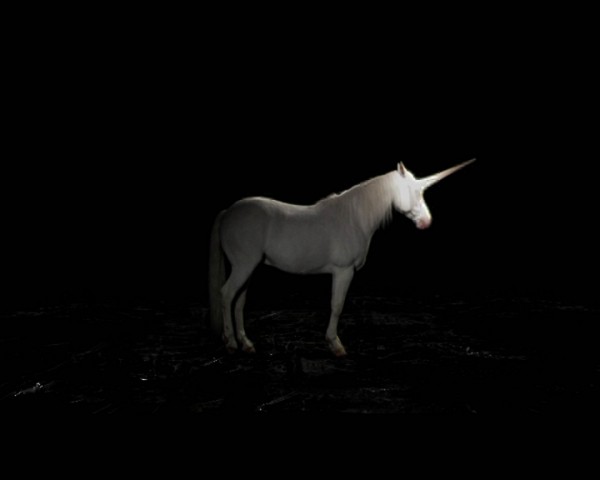
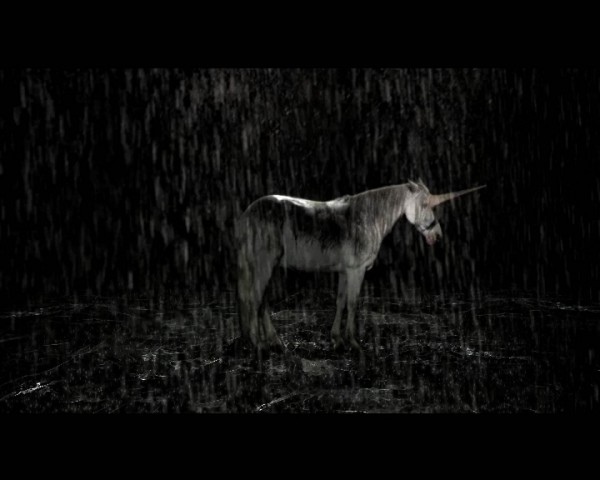
Totem (2001), a founding work in many respects, engages us with the spectral in a very different way. Maïder Fortuné is clearly the protagonist of the scene, but, costumed as Alice and wearing a brown wig, she appears as a fiction. This figure is born of I Games, video performances (5) in which the character, she explains, “is only there for the image and for the few gestures that constitute her raison d’être”. In Totem, the performative dimension—the jump roping—subsists, but the filmed body becomes matter and prop. Emerging from the black of the video—with its indeterminate depth,—the artist, only her face and shoulders visible, jumps in place, in such a way that she moves vertically, within the frame of the screen. The initial shot, one or two minutes long, is treated “blindly”, pulled and arranged so as to last ten minutes. Using a machine able to condense the number of photograms, or on the contrary, to generate nonexistent images from a few existing ones, Fortuné modifies the cadence of the act. The original repetitiveness is deconstructed, the succession of shots becomes superpositions and colliding sequences, following a marked arrhythmia. Not merely simply slow motions or acceleration, these temporal disruptions truly achieve a modeling of the video image.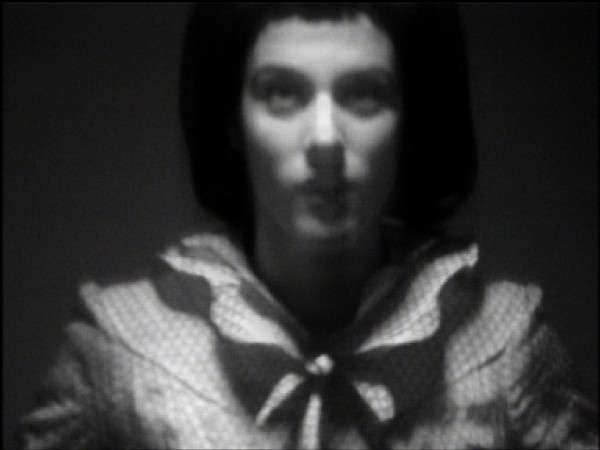
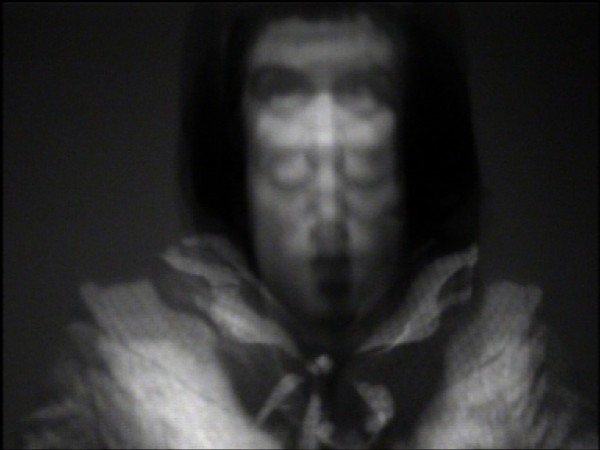
This image is seen as if fluidified, the hair and the collar of the garment participating in giving this impression. Sometimes the body seems to try to raise itself higher, escaping out of the frame, sometimes it seems to fall, as if sucked down from underneath. Both of these movements are perceived as a tearing motion, more or less violent, or a jerky plunge, that we could almost imagine as sub-aquatic. The metamorphoses of the face are due to the combination of diverse effects, such as stretching, blurs and superposition, more or less marked. The light, coming from underneath the eyebrows, the nose and the cheeks also affects the morphology of the head. We recall the self-portraits of Francis Bacon and his malleable flesh. To this are added the changes of expression; Maïder Fortuné moves from, as far as it is possible to judge, a smile to an expression of joy, and from concentration to fear. However, we cannot decide if these permanent expressions and defigurements really emanate from the traits of the artist’s face or if they are the result of manipulations of the image. Caught in this tension between the memory of a childhood game and the mortuary aspect of the representation, we probably project a psychology there where, definitively, there is only a gesture without affect.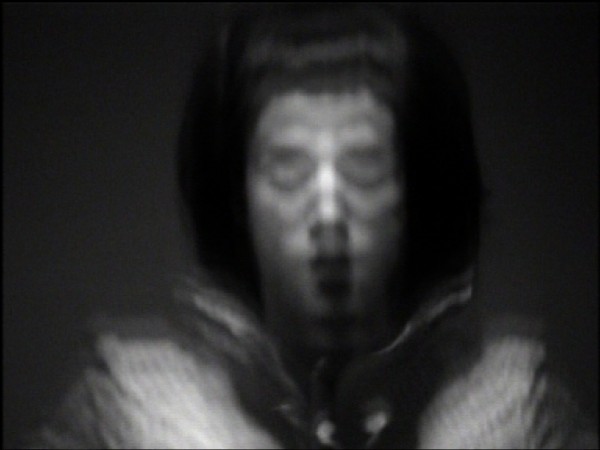
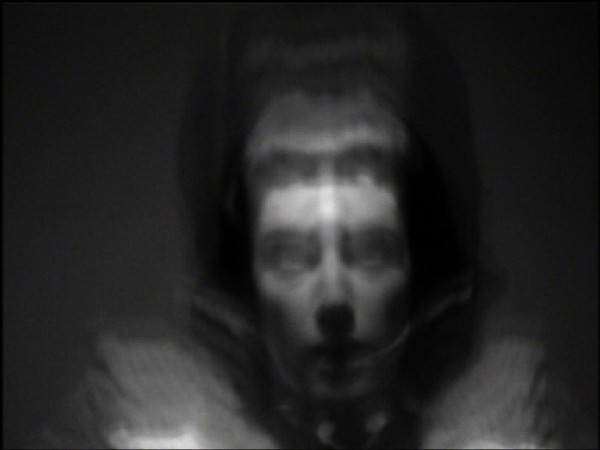
Between petrification and dissolution, construction and destruction, incarnation and dis-incarnation, the face becomes, as the artist says, “a pure being-image”. As in other earlier works, it is “the loss of the Subject which allows the face to open up”. The face is alternately that of a little girl and a clown (one thinks of Roni Hom’s Cloud and Clowns), mask and specter, skull even. Yet, if the self-portrait consists of sounding the identity of the Subject, this is a Subject in which the different ages of life are blended. We have before our eyes a thousand appearances, or more exactly the thousand passages from one state to another, since there is no pause in the image. The end of the video is the exception; the artist’s eyes, which until then have been turned upwards, are directed for a moment towards us, as if she had returned to the world after an unbelievable trial. Perhaps she restores what Barthes said he had experienced or analyzed in this way: “In imagination, Photography (the Photography I intend) represents that very subtle moment where, to be honest, I am neither a subject or object, but rather a subject that feels itself becoming an object: I then live a micro-experience of death (of the parentheses): I truly become a ghost” (6). Fortuné captures neither a presence nor an absence, she produces the impossible figuration of a psychic event, a “crossing through of death”, to use her expression. Amazed, the spectator truly perceives this crossing through—he sees the skull—in the paradoxically immaterial physicality of the videographic image (7).
Natacha Pugnet
Source : 20/27 n° 6, 2012, p. 268-285
Find all the works of Natacha Pugnet here and Maïder Fortuné’s Internet site here .
–———————————————————–
(1) All quotations from the artist have been taken from an interview with the author in July 2011.
(2) Jean-Louis Shefer, L’Homme ordinaire du cinéma, Paris, Petite bibliothèque des Cahiers du Cinéma, 1997 [1980], p.10.
(3) These two notions are borrowed from Paul Valéry, who defends the necessity for aesthetics to interweave the study of the production of works and that of sensations. See “Discours sur l’esthétique”, Paul Valéry. Œuvres, Paris, Gallimard, coll. «La pléiade», 1957 [1937], p. 1311.
(4) Raymond Bellour, L’Entre-images. Photo. Cinéma. Vidéo, Paris, La Différence, 2002, p. 14.
(5) In addition to training at Fresnoy, the artist studied at the Lecoq theater of movement school in Paris.
(6) Roland Barthes, La chambre claire. Note sur la photographie, Paris, Les Cahiers du Cinéma/éditions de l’étoile/Gallimard/Seuil, 1980, p. 30. Capital letters and italics are the author’s.
(7) Concerning the theory of ghosts developed by Balzac, Nazar writes: “According to Balzac, each body in nature is composed of a series of ghosts, in infinite, superposed layers, leafing into infinitesimal films in all directions where optics perceive this body. (…) Every Daguerrian operation (…) detaches and retains by applying to itself one of the layers of the objected body. From there, for the aforementioned body, and for each renewed operation, there is an evident loss of the ghost, or of part of its constitutional essence.” Nadar, quoted by Rosalind Krauss, Le photographique. Pour une théorie des écarts, Paris, Macula, 1990, p.21. The process used by Maïder Fortuné decomposes her face into spectral films, following a principle that, unlike photography, does not result from the exposure value, but from digital manipulation.

